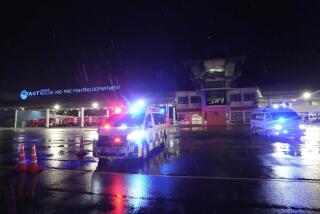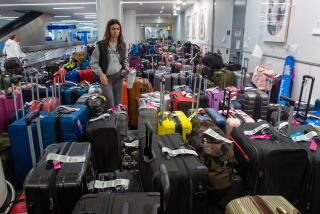Carrier Aims to Stay Above Rivals
SINGAPORE â On any given day, more than a dozen of Singapore Airlines Ltd.âs 747 and 777 jumbo jets depart here on flights to the U.S. packed with business and leisure travelers.
Few airlines can match the service in Singapore Airlinesâ first- and business-class cabins. Lobster thermidor, pan-seared pheasant, Chilean sea bass and other exotic meals are heated in steam ovens onboard, rather than in microwaves, and served on bone china with silverware. The airline flies one of the industryâs youngest plane fleets, equipped with seats that turn into beds, and passengers can select from 50 movies in five languages, plus 200 music CDs and 30 Nintendo games.
Regular travelers are familiar with the âSingapore Girls,â the airlineâs flight attendants, mostly women in their 20s who wear long sarongs and have a reputation for pampering passengers.
âThey are almost like the airline of the 1950s and 1960s that viewed flying as an experience, not an endurance test,â said Joe Brancatelli, a business travel consultant in New York.
Singapore Airlinesâ lofty image has enabled it to largely avoid competing on price and to draw long-distance travelers from other airlines as it flies to 34 countries.
âThe main driver has been the reputation for good service,â said Richard Aboulafia, aviation analyst with research firm Teal Group Corp.
Most rivals canât match Singapore Airlinesâ profit streak, either. Since launching in 1972, the airline has suffered only one unprofitable quarter. Buoyed by record passenger traffic, Singapore Airlines posted a $601-million profit on $6.17 billion in revenue for the nine months ended in December -- while most airlines were in the red. The company is expected to report record earnings for its fiscal year ending in March despite a 48% rise in fuel costs.
But for all the airlineâs success, the pressure is on to find more inventive ways to stay ahead of the competition as other international carriers have begun to catch up, analysts said.
Hong Kongâs Cathay Pacific Airlines is beefing up its in-flight service and last year wrested research firm SkyTraxâs top airline award from Singapore Airlines for the first time. Meanwhile, rival Emirates has surpassed Singapore Airlines in some luxury amenities by introducing a private suite on first-class flights from New York to Dubai. And United Airlines, which emerged from three years of bankruptcy protection last month, plans to spend $165 million upgrading first- and business-class seats on international flights.
Airlines focus on âfront-of-the-planeâ passengers because they can generate 70% of a flightâs profit even though they fill only about 30% of the airplaneâs space. A round-trip economy ticket from Los Angeles to Singapore, a route that can take as many as 20 hours, can be purchased two weeks in advance for about $1,000, while business class costs $5,000 and first class tops $10,000.
Another challenge for Singapore Airlines is that many of its planes are already near capacity. In January, 80% of its seats were occupied, compared with an industry average of 70%, and Singapore Airlinesâ busiest routes -- between the U.S. and Singapore, including flights out of LAX -- were 86% full.
âWeâre running out of planes and seats,â said James Boyd, the airlineâs spokesman in the U.S.
Chief Executive Chew Choon Seng has three strategies to help the airline stay in front: add bigger planes, find new routes and create additional touches of luxury to keep filling those high-priced seats.
Singapore Airlines is awaiting some new long-range wide-body jets so it can add extra flights to existing routes. At the end of this year, Singapore will be the first airline to take delivery of the biggest airliner ever built: the double-decker, Airbus A380, which can hold nearly 500 passengers.
However, Chewâs plan to secure some new international routes is running into headwinds.
Australian rival Qantas Airways fills three Boeing 747 jumbo jets daily on its LAX-to-Sydney flights. For more than a decade, Singapore Airlines has been trying to add an LAX-to-Sydney route. A Merrill Lynch research report estimates that one route could generate $270 million in additional revenue annually for Singapore Airlines.
But the Australian government rejected Singapore Airlinesâ request last month, leaving Qantas with a virtual monopoly of a route that generated nearly 20% of its profit last year. The only other airline allowed to fly from LAX to Sydney is United, which has one daily flight.
Singapore government officials reacted with uncharacteristic anger, accusing Australia of protectionism.
âNot being able to fly L.A. to Sydney is a problem for them,â travel consultant Brancatelli said. âWhere do they go now? There arenât too many places they can expand to.â
Although Singapore Airlines recently added flights to Moscow and Abu Dhabi from Singapore, it faces stiff competition to open new routes to China and India.
The airline has always focused on international trips because of geographic constraints. Singapore, a tiny island about half the size of Los Angeles County with only 3 million residents, has little domestic air traffic. So the airline has marketed itself to well-to-do travelers willing to stop over in Singapore on their way to their final destination in Asia. Air India, for instance, offers direct flights from L.A. to New Delhi, but Singapore Airlines has higher passenger loads on its flights to India that make a stop in Singapore.
Although the company invests heavily on planes and training, it keeps other expenses at a minimum.
Its headquarters at the Singapore airport is on the top floor of a working airplane hangar next to its aircraft maintenance facility. The sparse offices have a few posters of Boeing airplanes pinned to the walls and furniture that seem to have been left over from the 1960s.
The airline said it preferred to invest its money into services that customers can see.
The company has a kitchen in Singapore that bakes its own bread and makes fresh chocolates before all flights. The airline also began providing live TV broadcasts of U.S. and British networks on its flights across the Pacific, the first of its kind.
And it recently spent $1 million to build the first pressurized flight simulator with an aircraft galley to mimic the conditions of preparing and serving meals at 35,000 feet.
âIn the air, the taste buds get less sensitive, so you have to flavor the food a little moreâ to improve its taste, said Betty Wong, Singapore Airlinesâ vice president for in-flight services.
The airline gets plenty of flight attendant applications, but only about 10% of candidates survive the training program. New flight attendants must endure four months of classes, including wine appreciation courses so that when a passenger asks for a recommendation, the flight attendant can detail the difference between a Cabernet and a Merlot. The image of its flight attendants is so well-known that a Singapore Girl wax figure is on display at Madame Tussauds wax museum in London.
A Singapore Airlines executive said one difference between the airline and its rivals was that Singaporeâs flight attendants were trained to unwrap a blanket and place it on a passenger instead of just handing it out in a plastic case.
âItâs not just about the food, the fleet or the schedule,â Wong said. âItâs also about soft touches and paying attention to little things.â
More to Read
Inside the business of entertainment
The Wide Shot brings you news, analysis and insights on everything from streaming wars to production â and what it all means for the future.
You may occasionally receive promotional content from the Los Angeles Times.










